Perched precariously on a cliff side some 2,600 feet above the Paro Valley in the Kingdom of Bhutan is the legendary Taktsang Monastery, popularly known as the Tiger’s Nest.
A trip to Bhutan is incomplete without visiting this distinguished icon of Bhutan, a monastery built in the 16th century.
Legend has it that Guru Padmasambhava, also commonly known as Guru Rinpoche, first arrived in Bhutan on a flying pregnant tigress.
In the 8th century and meditated in a cave on this very cliff for 3 years 3 months, 3 weeks and 3 days before subduing a local demon who has been terrorizing the local inhabitants of the nearby valley.
The most revered Guru Rinpoche is also credited for introducing Buddhism to Bhutan and much of the Himalayan region.
From Tiger’s Nest, Guru Rinpoche traversed much of Bhutan, quelled demons and brought long-lasting peace to the valleys in the country.
History of Tiger’s Nest
The monastery was first built in 1692 by Tenzin Rabgye, who ruled Western Bhutan from 1680 to 1694 as the fourth Druk Desi (Secular Leader).
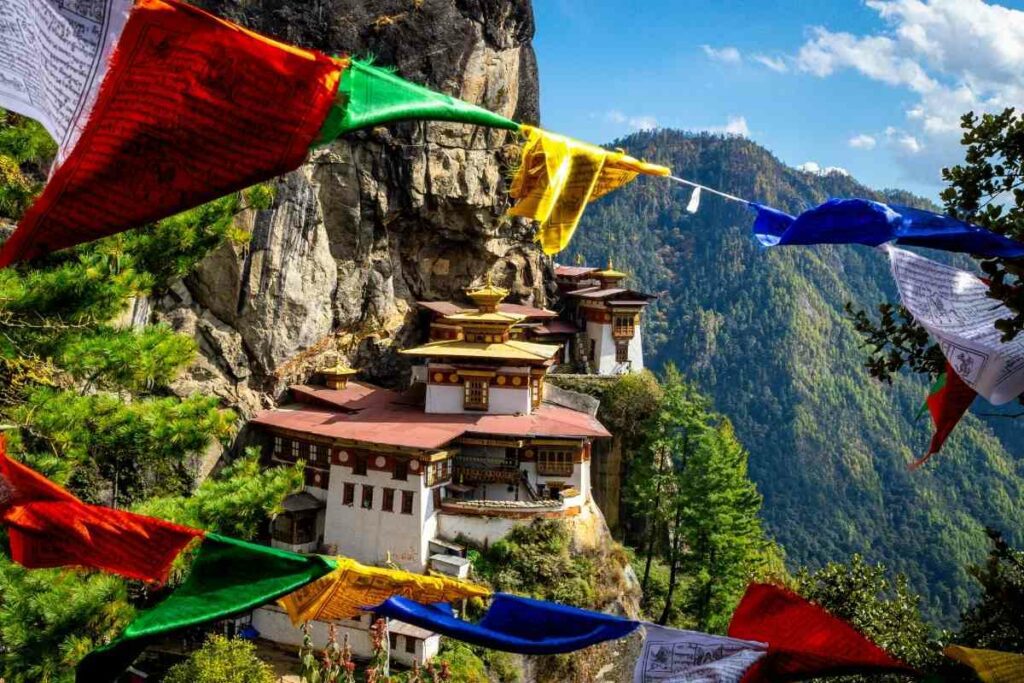
It was said that he visited the sacred cave of Taktsang Pelphug during the Tsechu (festival) season and ordered the construction of the first temple around the holy cave in which Guru Rinpoche meditated to honor the great saint.
The construction of the temple, Taktsang Lhakhang (the Temple of the Guru with Eight Names), was completed in 1694.
The Shrine of the Self-Speaking Guru
The Taktsang Monastery’s most sacred relic is the Guru Sungjonma statue or the statue that ‘spoke’.
The story goes that the bronze statue of Guru Sungjonma was sculpted by Pentsa Deva at Punakha Thangdzong and was brought to Taktsang.
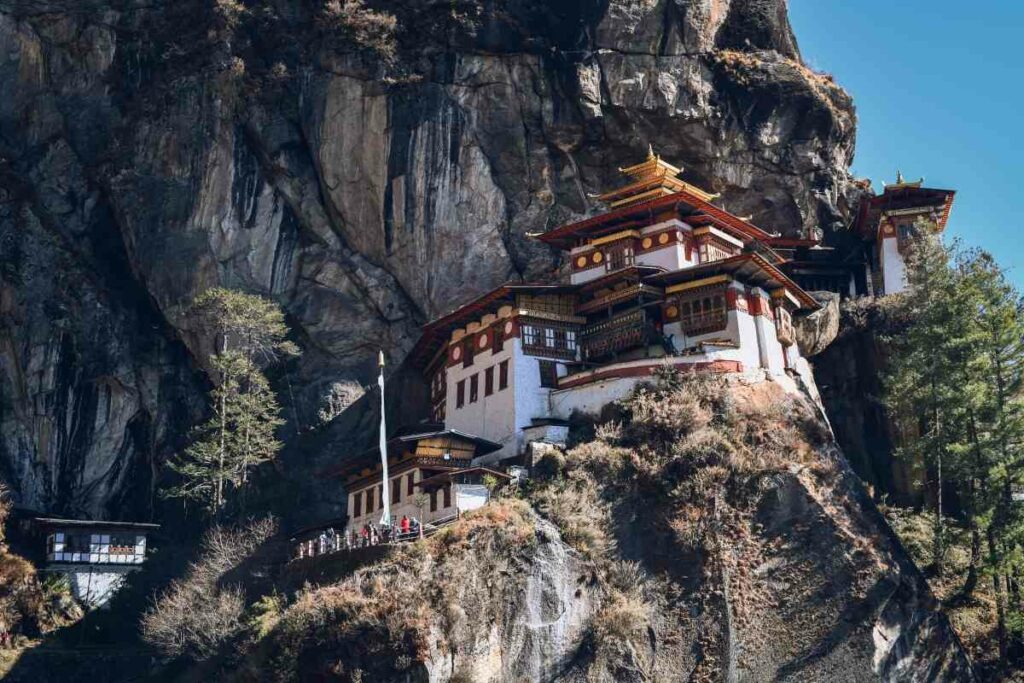
Upon arriving at the cliff across the sacred site of Taktsang, the monks were at a loss on how to carry the 12-feet statue across the canyon to the temple site.
The statue is supposed to have said “Do not worry, for someone shall come to carry me to Taktsang!”
The next morning, the statue was miraculously transported across the canyon and, thereafter, the place is known as the Temple of the Self-Speaking Statue of the Guru.
Featured article – Best Texas State Parks For Camping
The Structure of Tiger’s Nest
Over the years, more temples were added around the main temple of Guru Rinpoche and there are now four temples surrounding the main temple of Taktsang Lhakhang.
All the buildings in the complex are interconnected by staircases with steps carved into the rock.
The exterior of the complex has white-washed walls with gold painted roofs.
A prayer wheel is located in the courtyard and it is turned by the residing monks daily at 4 a.m. to mark the beginning of a new day.
The interior of the temples are also decorated with the finest details to reflect the finest Varjayana Buddhist tradition.
The current structure that exists was reconstructed in 2005 after a fire devastated the site on 19th April 1998.
The meticulous reconstruction to its full glory was spearheaded by the Fourth King of Bhutan, His Majesty Jigme Singye Wangchuck.
During this fire, and the one in 1951, the speaking bronze statue of Guru Sungjonma is the only item that miraculously survived unscathed in both times.
Visiting Tiger’s Nest
The only way to visit Tiger’s Nest is by foot or by taking a mule half way up the steep climb.
Depending on one’s fitness, the trek up and down from Tiger’s Nest and the visit to the various temples can take anywhere from 3.5 hours up to 9 hours.
It is advisable to start your trip as early as 6 a.m. to avoid the afternoon sun.
The total distance to reach the temple is approximately 4.3 km with an elevation ascent of 650 metres.
There is a steep climb from the starting point to the 2 km mark where you will find a cafeteria, a busy stopping point for hikers.
Travelers will then proceed another 2 km on a gentler slope to reach the second viewpoint.
After stopping to take in this breath-taking view you will next find a set of concrete steps descending into the canyon below which passes by a waterfall over a bridge and is followed by the final ascent of 120 steps bringing the tired hiker to the main entrance of Tiger’s Nest.
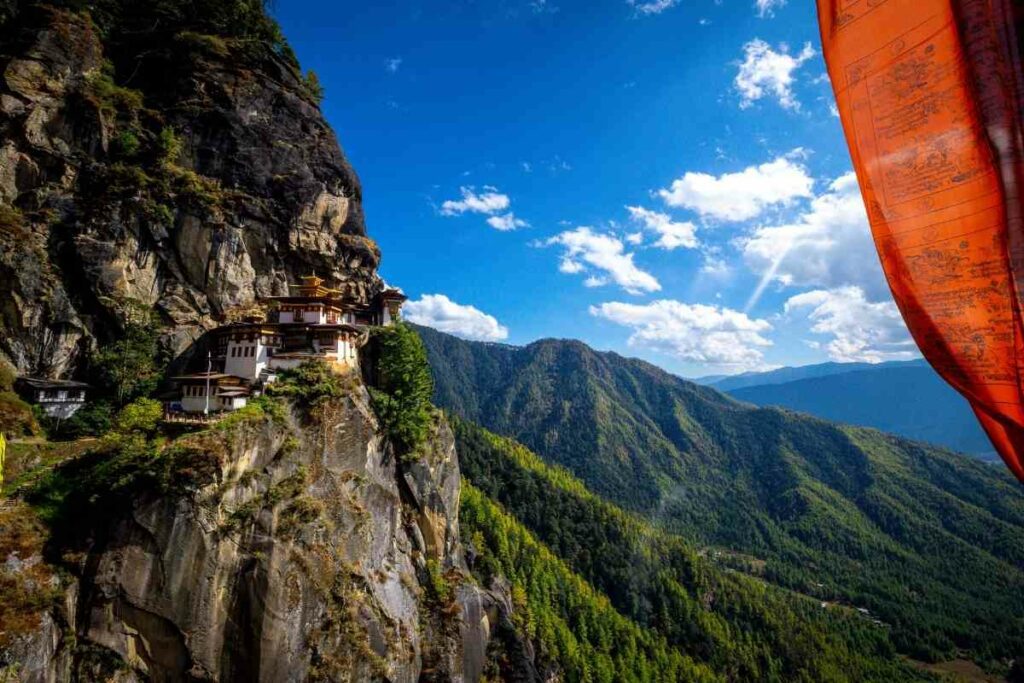
Along the way, you will walk past many colourful prayer flags the Bhutanese have strung up to catch the wind and to bring compassion and blessings to all sentient beings.
These colourful prayer flags called Lung Dhar, appear in five colours representing the five elements of nature: red for fire, blue for water, yellow for the earth, white for the sky and green for vegetation.
Visiting Tiger’s Nest is a holy pilgrimage for the locals.
The Bhutanese will only visit Tiger’s Nest by foot to demonstrate one’s utmost sincerity for the pilgrimage.
It is not uncommon for them to reach the temple in 45 minutes by foot and also hiking with just their sandals!
At Times – You will see young adults carrying a baby on their back or even their aged parents up to the Tiger’s Nest for a special visit, such is the faith of the most devoted.
Visitors are required to deposit all electronic and photography equipment with the sentry before entering the temple complex.
Photography is not just prohibited in Tiger’s Nest but inside all the monasteries in Bhutan.
Before entering each temple, visitors are also required to remove their shoes and any head coverings.
Visitors are welcome and encouraged to meditate in the quiet and peacefulness of the temples and experience the serene and enigmatic energy of this iconic fabled shrine.
Most Auspicious Day to visit Tiger’s Nest
The sacred cave of Guru Rinpoche, Taktsang Pelphug, is opened for public viewing and prayers once every year.
On the 30th day of the 5th lunar month, pilgrims from all walks of life, from all over the country and some from overseas, will flock to Paro to hike up to Tiger’s Nest to be a part of this most auspicious opportunity to visit this legendary cave where Guru Rinpoche meditated in the 8th century.
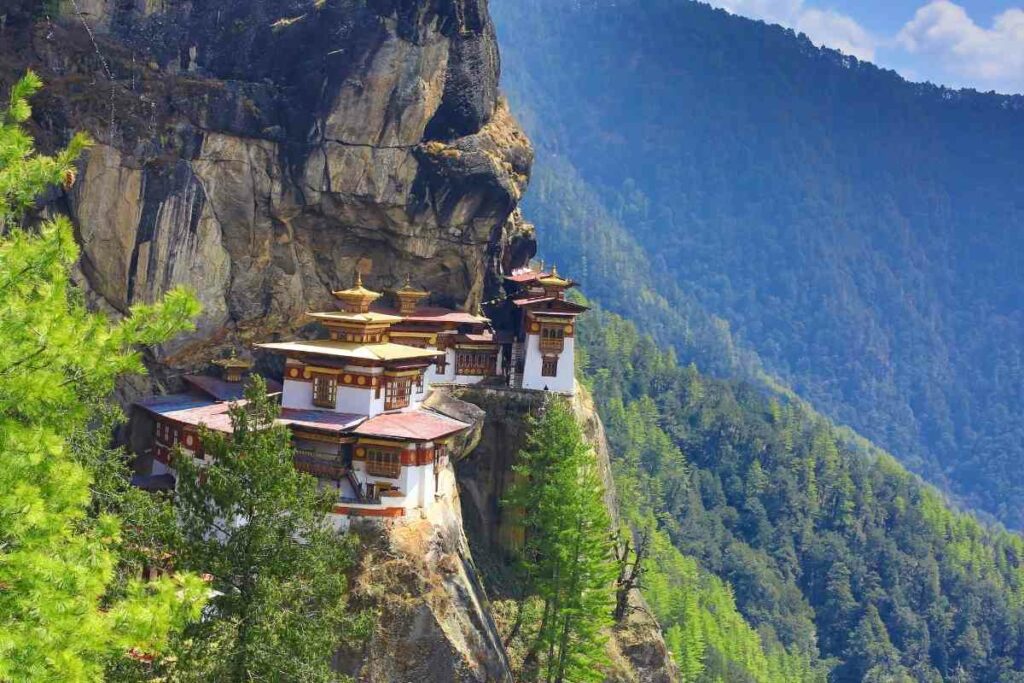
To avoid swelling crowds during the day, some start their journey up the steep slope as early as 3 am.
The queues to enter this sacred cave on this special day can be particularly long and will stretch to the second view point.
It is said that a visit on this auspicious day will accumulate much merit towards one’s future rebirth.
In Buddhism an auspicious day is one where any karmic actions are said to be multiplied by 100 Million.
Bumdra Trek – Alternative Route to Tiger’s Nest
Besides taking the foot trail to Tiger’s Nest, one can also opt to visit Tiger’s Nest via the Bumdra Trek route.
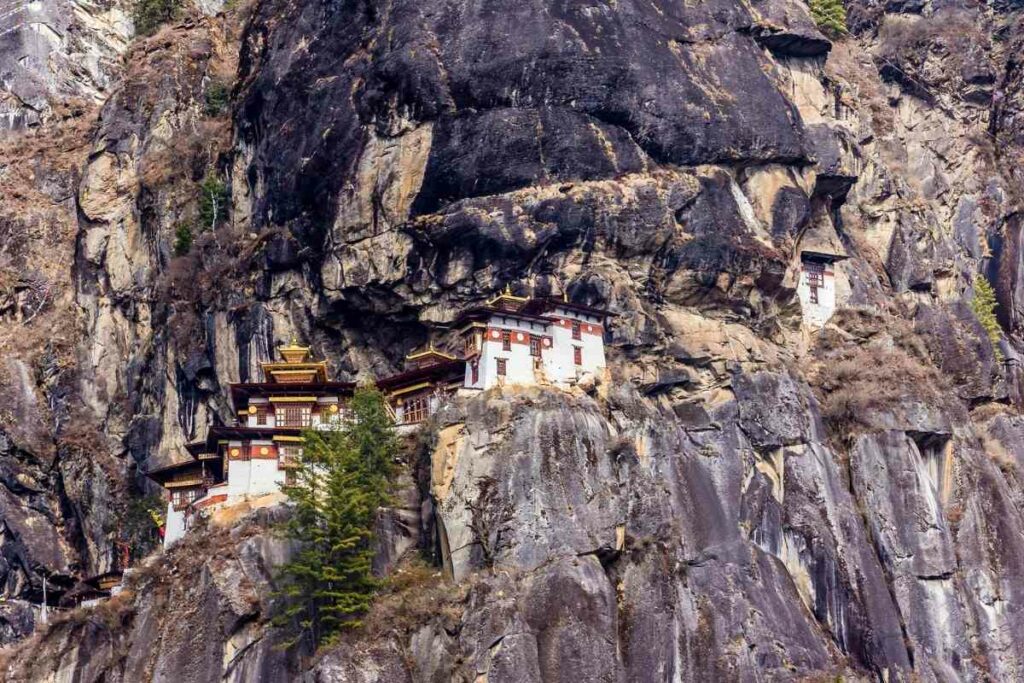
Bumdra trek is a scenic hiking trail with a panoramic view of the Paro valley, that leads one to Bumdra Monastery, a temple above Tiger’s Nest.
This one day hike with an overnight stay in a camp will allow the visitors to trek down to Tiger’s Nest the next morning.
The hike to Tiger’s Nest from Bumdra is about 2 – 3 hours. This trek is available all year round.
Royalty & Celebrities Who Visited Tiger’s Nest
Over the years, many prominent people from all over the world have visited this majestic icon of Bhutan.
Some of these personalities include royals from the House of Windsor like Prince Charles who stopped to do a painting of the Tiger’s Nest near the cafeteria in 1998.
The Duke and Duchess of Cambridge, Prince William and Kate Middleton also visited Bhutan on the invitation of the Fifth King of Bhutan, His Majesty Jigme Khesar Namgyel Wangchuck in 2016.
- From Japan – Princess Mako and Crown Prince Akishino also visited Tiger’s Nest in 2018 and 2019 respectively. Other royalties included the royal families from Thailand, Norway and many more Europeans royalties.
- From Asia – Jet Li meditated at Tiger’s Nest in 2017 and actor Tony Leung, famed for holding his wedding in Bhutan back in 2008, is also rumoured to be a frequent visitor of Bhutan and Tiger’s Nest.
- From Hollywood – Cameron Diaz, Michael J. Fox, Drew Berrymore, Demi Moore and Leonardo DiCaprio have all visited Bhutan and the Tiger’s Nest throughout the years.
Perhaps one show that brought Bhutan to the fore for Hollywood would be “Little Buddha” where Keanu Reeve plays the role of Siddhartha in this 1993 movie .
You may also have spotted a black and white photo of Tiger’s Nest in Guy Richie’s most recent movie “The Gentlemen”.
Look out for the photo of Tiger’s Nest in Charlie Hunman’s kitchen when he was negotiating with Huge Grant.
In Fact – A photo of Tiger’s Nest has been spotted in quite a few movie sets as a little background detail.
How to visit Bhutan and Tiger’s Nest
Flying in to Bhutan
Flights can only be booked through the national airline, Royal Bhutan Airlines (known as Drukair) or the privately owned Tashi Airlines (known as Bhutan Airlines).
Both airlines operate Airbus A319s and fly to the nearby cities in Asia namely, Kathmandu in Nepal, Delhi in India and Bangkok in Thailand.
In addition to those cities, Drukair also flies to Singapore’s Changi Airport and Hazrat Shahjalal International Airport in Dhaka, Bangladesh.
Both airlines will fly to Paro International Airport, the only international gateway to Bhutan and one of most challenging airports in the world to land in to.
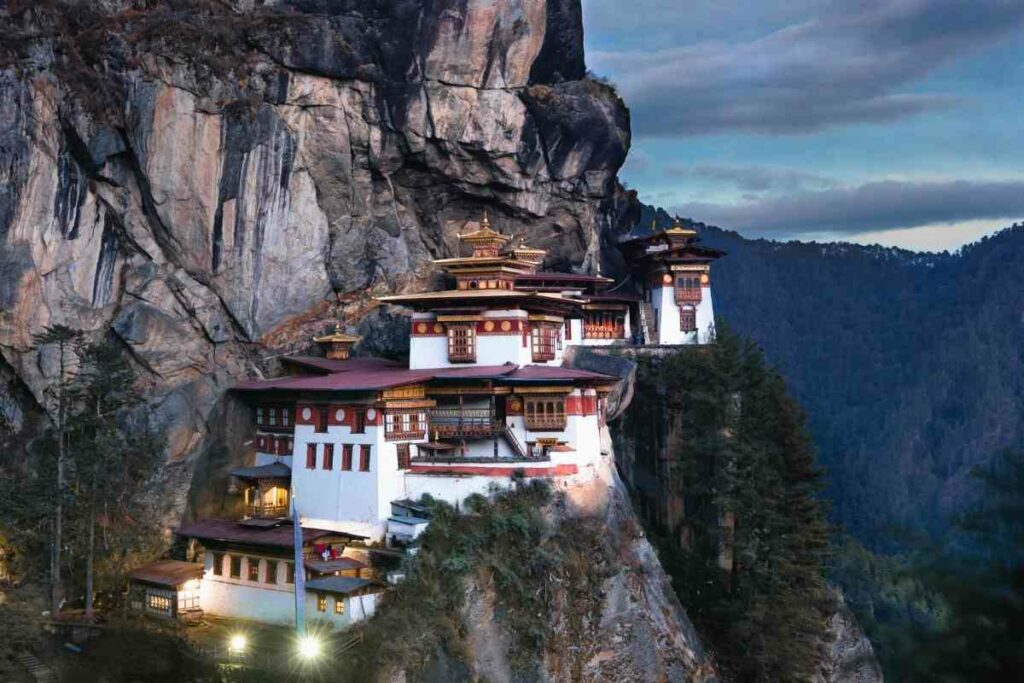
Other airports rely on ILS (Instrumental Landing Systems) to guide the aircraft laterally and vertically in an approach to landing.
At Paro, the pilots only have one VOR (Very high-frequency Omni-directional Range) to guide them and rely mostly on their sights and experience to land the aircraft.
Most airports offer at least 10 nautical miles (that’s about 18km) of distance for pilots to gauge an aligned approach onto the landing strip, Paro airport has only one to two nautical miles.
All the factors above demand that only a handful of certified pilots can land in Bhutan. Fasten your seat-belts!
Visa to Bhutan
All visitors are required to process their tourist visa to Bhutan through licensed tour operators like Druk Asia.
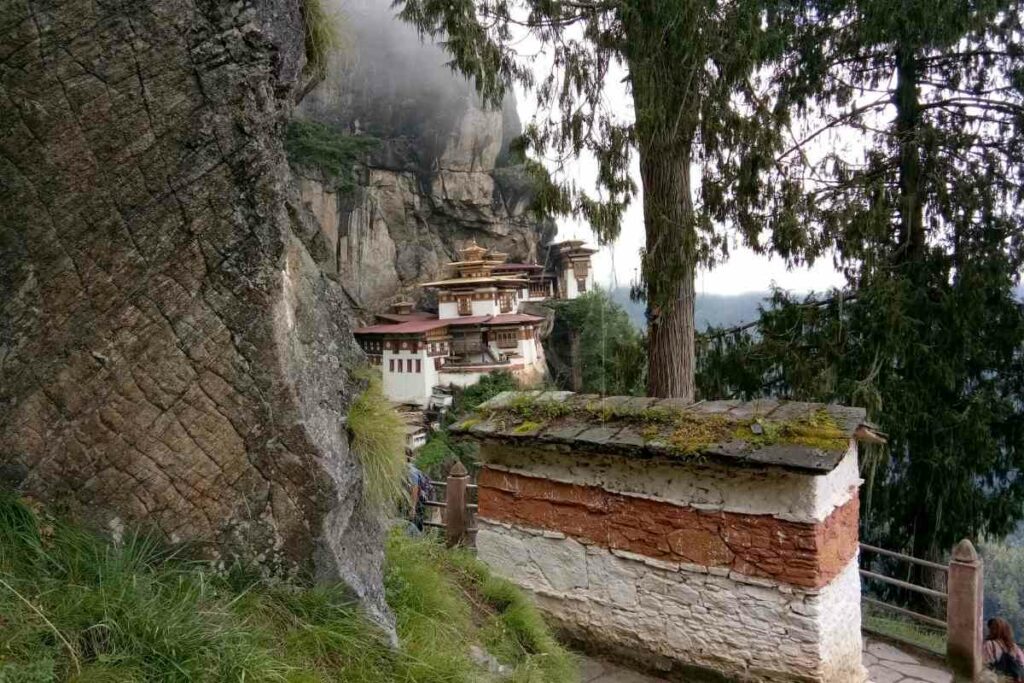
There is a fixed daily charge for all tourists, as the government of Bhutan strictly adheres to a ‘High Value, Low Impact’ tourism policy in order to preserve it’s national culture, identity and the natural environment.
The tariff covers the following cost and services:
- All internal taxes and charges
- USD65 sustainable development fee used by government to provide free education and healthcare services
- 3 meals a day
- A licensed English speaking Bhutanese tour guide throughout your trip
- All transport on the ground including driver (excluding internal flights)
- A minimum 3 star accommodation (4 & 5 star will require additional premium)
- Entrance fees to tourist attractions
- Camping equipment and haulage for trekking tours (if applicable)
Planning for your hike to Tiger’s Nest
A trip to Bhutan without visiting Tiger’s Nest would be considered incomplete.
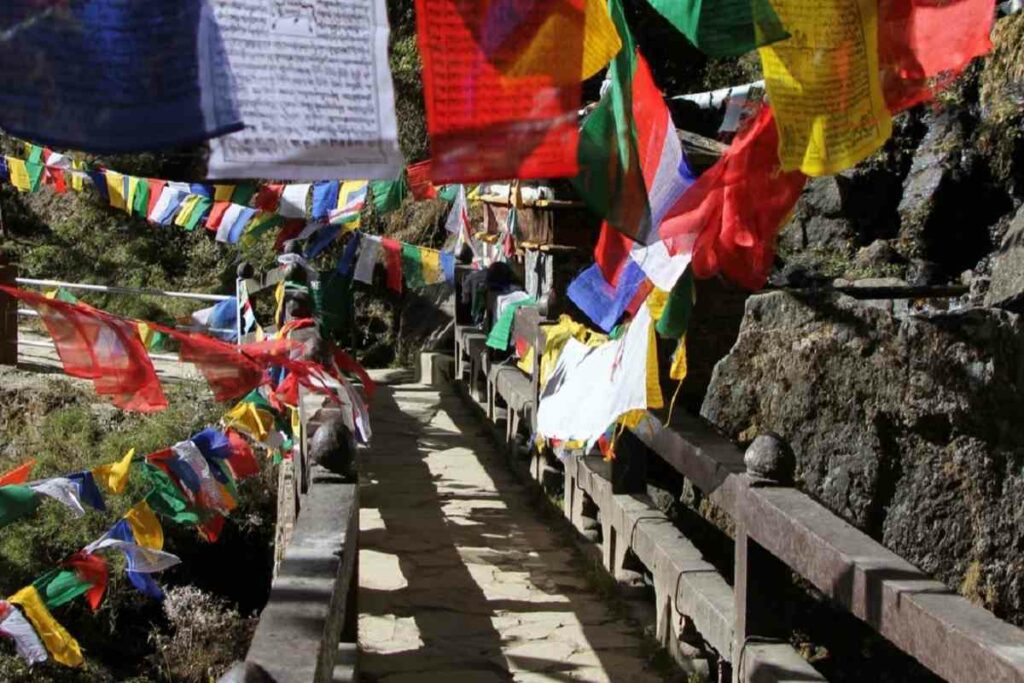
Here’s what you should take note to make sure that you have a pleasant hike to reach this fabled temple:
- Start early if you want to avoid the crowd and the heat.
- Wear a pair of good walking shoes to protect your ankles, bring a hat and sunscreen.
- You can also rent a walking stick at the base of Tiger’s Nest if required.
- Stay hydrated and take your time. The ascent gains an elevation of 700 m, although it is below an altitude of 3000m, it is wise to pace yourself to avoid overexertion and result in altitude sickness.
- Regulate your breathing to avoid panting. You will expend more energy if you pant.
- Bring a warm jacket as your body cools down pretty fast when you are visiting the temple.
- Bring some snacks or energy bar to chew on once you reach the peak to restore your energy and keep warm for the return journey.
Further reading – A complete travellers guide to South East Asia Vietnam vs Indonesia



